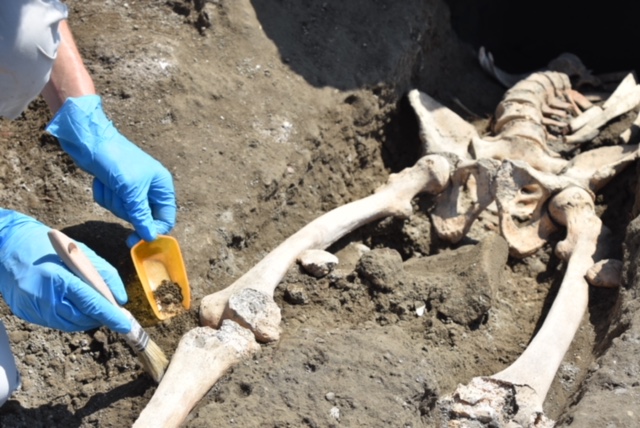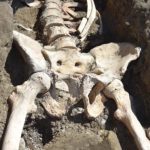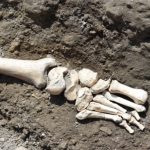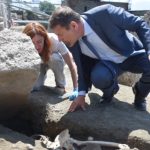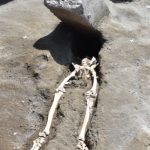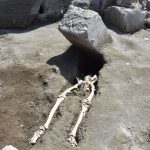IN THE ESCAPE FROM ERUPTION THE FIRST VICTIM IN THE SITE OF NEW EXCAVATIONS IS EMERGED
The chest crushed by a large block of stone, the body thrown back by the powerful pyroclastic flow, in a desperate attempt to escape from the eruptive fury. It is in this dramatic position that emerges the first victim of the site of the new excavations of the Royal V.
The skeleton was found at the intersection of the Vicolo delle Nozze d’Argento and the Vicolo dei Balconi, recently discovered, which extends towards Via di Nola. From the first observations, it appears that the individual who survived the early stages of the volcanic eruption, ventured in search of salvation along the alley now overgrown by the thick lap of lapilli. The body was in fact found at the first floor of the adjacent building, or above the lapilli layer. Here he was hit by the thick and dense pyroclastic cloud that threw him backwards.
An imposing block in stone (perhaps a jamb), dragged violently by the cloud, hit him in the upper portion, crushing the upper part of the chest and the head that, still unidentified, lie at a lower altitude than the lower limbs, probably under the lytic block.
The first analyzes performed by the anthropologist, during the excavation, identify an adult man aged over 30 years. The presence of lesions at the tibia level signals a bone infection, which may have been the cause of significant difficulties in walking, such as to prevent the man from escaping the first dramatic signs that preceded the eruption.
“This exceptional find, – says Massimo Osanna, Director General of the Archaeological Park of Pompeii – refers to the similar case of a skeleton found by Amedeo Maiuri in the house of the Blacksmith and recently studied. These are the remains of a limping individual, who was also probably prevented from escaping from motor difficulties and left at the time on site.
Beyond the emotional impact of these discoveries, the possibility of comparing these discoveries, comparing pathologies and lifestyles, the dynamics of escape from the eruption, but above all of investigating them with tools and professionalism that are increasingly specific and present in the field , contribute to an increasingly precise story of the history and civilization of the time, which is the basis of archaeological research. ”
The new excavations of the Regio V, where this last extraordinary discovery took place, are part of the construction site for securing the excavation fronts inside the ancient city, envisaged by the Great Pompeii Project. The archaeological investigations in progress are affecting the area of the so-called “Cuneo”, located between the house of the Silver Wedding and the home of Marco Lucrezio Frontone.





